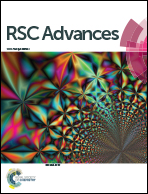Coupling a novel spiro-rhodamine B lactam derivative to Fe3O4 nanoparticles for visual detection of free copper ions with high sensitivity and specificity†
Abstract
We herein reported a novel spiro-rhodamine B lactam derivative (RhBLA), which can be coupled to Fe3O4 nanoparticles (NPs) and act as a Cu2+-selective visual sensor. We demonstrated that the RhBLA-functionalized Fe3O4 NPs can specifically chelate with Cu2+ to create a colour change from colourless to pink, which provides a sensing platform for the simple, rapid and field-portable visual detection of trace Cu2+. By using this sensing platform, a sensitive and specific visual sensor for the rapid and on-site detection of trace Cu2+ was developed. The coupling of RhBLA to Fe3O4 NPs facilitates the magnetic separation of Cu2+ from a bulk sample solution, which leads to the selective detection of Cu2+ at low concentration and the robust resistibility of the sensor to the matrix of the sample. The proposed visual sensor can be used to directly detect as little as 50 nM of Cu2+, which is much lower than the maximum allowable level of Cu2+ (∼20 μM) in drinking water defined by the USA EPA, in 100 mL of river or tap water by only naked-eye observation within 15 min. In addition, the method proposed in this study is simple, cost effective, rapid, and does not need any sophisticated instruments. The above features make our sensor a promising approach for the rapid and on-site visual detection of ultra-trace free copper ions in aqueous environments by only naked-eye observation.


 Please wait while we load your content...
Please wait while we load your content...